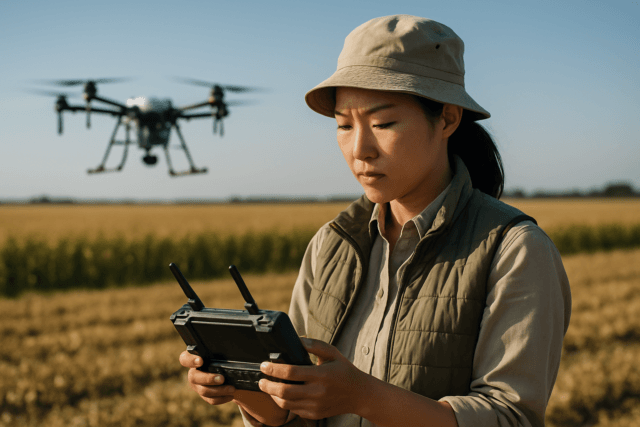The integration of drones into precision agriculture has revolutionized farming practices, offering unprecedented efficiency in surveying, crop health monitoring, and resource distribution. At the heart of this technological leap lies the drone’s battery system, a critical component whose proper management directly impacts operational productivity, performance, and safety. Understanding and implementing best practices for drone battery care is essential for farmers to maximize their investment and ensure consistent, reliable drone operations.
Understanding Agricultural Drone Battery Types and Characteristics
Agricultural drones primarily rely on high-capacity Lithium Polymer (LiPo) and, to a lesser extent, Lithium-ion (Li-ion) batteries due to their superior power-to-weight ratio, energy density, and high discharge rates. These characteristics are crucial for handling heavy payloads like pesticide tanks, multi-sensor cameras, and GPS modules, which demand a consistent and powerful energy source.
Key specifications to consider for agricultural drone batteries include:
- Voltage: Determines motor power output, typically ranging from 44.4V to 51.8V.
- Capacity (mAh): Measures stored energy and directly influences flight duration. Common capacities range from 12,000 to 29,000 mAh, with higher capacities extending flight times to 25-30 minutes or more.
- Discharge Rate (C-Rating): Indicates power delivery efficiency, usually between 10C and 25C.
- Cycle Life: Reflects long-term durability, with LiPo batteries lasting up to 1,000 charge cycles if properly maintained.
Pre-Flight Battery Preparation and Charging
Proper preparation before flight is crucial for battery performance and longevity.
Optimal Charging Practices
Always use manufacturer-approved chargers specifically designed for your drone battery type, ensuring it includes a balancing feature. Balance charging ensures that all cells in the battery are evenly charged, preventing imbalances that can reduce performance or cause failure.
- Charge Rate: Charging at 1C (one times the battery’s capacity) is generally recommended for safety and to reduce strain on the battery. For instance, a 1500mAh LiPo battery would be charged at 1.5A. While some newer batteries support faster charging at 3C or even 5C, it’s safer to stick to 1C for new batteries during their initial cycles.
- Temperature: Never charge a battery immediately after a flight when it is still warm; allow it to cool down first. Batteries should be charged in a well-ventilated, cool, dry area, away from flammable materials, with an ideal temperature between 10-25°C (50-77°F). Avoid charging batteries below 0°C (32°F) as this risks explosion.
- Monitoring: Never leave batteries unattended while charging due to the risk of overheating or fire. Monitor the battery’s temperature and stop charging immediately if it overheats.
Battery Warm-up and Calibration
In cold weather, batteries’ voltage can drop quickly, leading to reduced performance and shorter flight times. It is recommended to pre-warm batteries to around 20°C (68°F) before takeoff, such as by keeping them in a warm indoor environment, a car, or a thermal box. Calibrating the battery before each flight allows the drone to accurately measure voltage and capacity, optimizing power usage and preventing unexpected shutdowns.
Pre-Flight Inspections
Before every flight, conduct a routine check of the battery’s health. Inspect for signs of swelling, damage, deformation, corrosion, or leakage. Clean battery surfaces and connectors to remove any residue and ensure secure connections.
In-Field Battery Management Strategies
Effective battery management during operations can significantly enhance efficiency and safety.
Monitoring Battery Health During Flight
Utilize the drone’s monitoring system for real-time battery status. It’s crucial to land the drone when the battery reaches a safe minimum voltage, typically around 3.5V to 3.6V per cell, to prevent over-discharge. Most modern drones have Battery Management Systems (BMS) that can prevent over-discharge by initiating an automatic landing. Over-discharging can cause irreversible damage, such as performance degradation, swelling, and reduced lifespan.
Swapping Batteries Efficiently
For extensive operations, rotate at least three battery sets to maintain continuous drone operation. Having spare, high-capacity batteries ensures longer flight times and fewer interruptions for recharging, which is particularly important during busy farming seasons.
Environmental Considerations
Flight conditions like temperature and wind significantly influence battery performance.
- Temperature: Avoid flying in extreme heat or cold, as these conditions can reduce battery capacity, efficiency, and overall lifespan. If flying in cold temperatures, shorten flight times to about half of normal to ensure safety.
- Wind: Strong winds increase power consumption, so planning flights during calm weather or adjusting routes to account for wind patterns can conserve battery power.
- Payload: Minimize unnecessary weight on the drone, as heavier loads require more power and drain batteries faster.
Post-Flight Care and Storage
Proper care after use and during storage is vital for extending battery lifespan.
Proper Discharge Levels for Storage
For short-term storage (over 48 hours) or long-term storage, batteries should be discharged to a “storage charge” of 40-60% capacity (around 3.8V to 3.85V per cell). Storing fully charged or below 20% can lead to degradation and damage. Many balance chargers have a specific storage mode for this purpose.
Long-Term Storage Best Practices
Store batteries in a cool, dry place, away from direct sunlight, moisture, and extreme temperatures (ideally between 10-25°C or 68-77°F). For added safety, use a fireproof container, such as a LiPo storage bag or a metal box, to minimize risks in case of malfunction. Keep batteries separate from agricultural chemicals to prevent corrosion. If storing for extended periods, regularly check battery voltage (every two months) and recharge to the recommended storage level to prevent over-discharge.
Cleaning and Inspection After Use
After operations, wipe down batteries to remove any residue, especially if used near agricultural chemicals, to prevent corrosion and damage. Continue to inspect regularly for any signs of physical damage or swelling, and replace faulty batteries promptly.
Maintenance and Longevity
Proactive maintenance practices contribute significantly to the overall health and lifespan of drone batteries.
Regular Cycling and Capacity Checks
While the articles do not explicitly mention “regular cycling and capacity checks” as a separate point, the general theme of “regular inspection”, “regular charge”, and “keeping track of your battery’s performance” implies the need for monitoring battery health over time. Replacing batteries when their capacity diminishes is crucial to avoid reduced flight time and mid-flight failures.
Identifying and Addressing Damaged Batteries
Damaged or puffy LiPo batteries can indicate defective cells, leading to higher internal resistance and increased temperature during charging. If any damage, swelling, or performance drop is observed, the battery should be retired and replaced immediately to prevent accidents or malfunctions.
Safety Precautions and Disposal
- Fire Prevention: Always charge batteries in a fireproof area and never leave them unattended. Have fire extinguishing equipment (like dry sand or a fire extinguisher) readily available.
- Disposal: Dispose of depleted batteries safely. One recommended method is to soak them in saltwater for at least 72 hours to fully discharge them before drying and disposal.
- Manufacturer Guidelines: Always adhere to the manufacturer’s specific guidelines for battery usage, maintenance, and replacement, as these are tailored to the drone model and battery type.
By diligently following these best practices for drone battery management, farmers can ensure the safe, efficient, and productive operation of their agricultural drones, maximizing flight times, extending battery lifespan, and ultimately enhancing their precision agriculture efforts.





